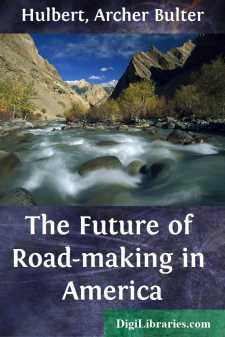Categories
- Antiques & Collectibles 13
- Architecture 36
- Art 48
- Bibles 22
- Biography & Autobiography 813
- Body, Mind & Spirit 142
- Business & Economics 28
- Children's Books 14
- Children's Fiction 11
- Computers 4
- Cooking 94
- Crafts & Hobbies 4
- Drama 346
- Education 46
- Family & Relationships 57
- Fiction 11828
- Games 19
- Gardening 17
- Health & Fitness 34
- History 1377
- House & Home 1
- Humor 147
- Juvenile Fiction 1873
- Juvenile Nonfiction 202
- Language Arts & Disciplines 88
- Law 16
- Literary Collections 686
- Literary Criticism 179
- Mathematics 13
- Medical 41
- Music 40
- Nature 179
- Non-Classifiable 1768
- Performing Arts 7
- Periodicals 1453
- Philosophy 64
- Photography 2
- Poetry 896
- Political Science 203
- Psychology 42
- Reference 154
- Religion 513
- Science 126
- Self-Help 84
- Social Science 81
- Sports & Recreation 34
- Study Aids 3
- Technology & Engineering 59
- Transportation 23
- Travel 463
- True Crime 29
The Future of Road-making in America
Description:
Excerpt
CHAPTER I
In introducing the subject of the future of road-making in America, it may first be observed that there is to be a future in road-building on this continent. We have today probably the poorest roads of any civilized nation; although, considering the extent of our roads, which cover perhaps a million and a half miles, we of course have the best roads of any nation of similar age. As we have elsewhere shown, the era of railway building eclipsed the great era of road and canal building in the third and fourth decades of the old century, and it is interesting to note that freight rates on American railways today are cheaper than on any railways in any other country of the world. To move a ton of freight in England one hundred miles today, you pay two dollars and thirty cents; in Germany, two dollars; in France, one dollar and seventy-five cents; in "poor downtrodden" Russia, one dollar and thirty cents. But in America it costs on the average only seventy-two cents. This is good, but it does not by any means answer all the conditions; the average American farm is located todayâeven with our vast network of railwaysâat least ten miles from a railroad station. Now railway building has about reached its limit so far as mileage is concerned in this country; in the words of Stuyvesant Fish, president of the Illinois Central Railroad Company, we have "in the United States generally, a sufficiency of railroads." Thus the average farm is left a dozen miles from a railway, and in all probability will be that far away a century from now. And note: seventy-five per cent of the commerce of the world starts for its destination on wagon roads, and we pay annually in the United States six hundred million dollars freightage to get our produce over our highways from the farms to the railways.
Let me restate these important facts: the average American farm is ten miles from a railway; the railways have about reached their limit of growth territorially; and we pay six hundred million dollars every year to get the seventy-five per cent of our raw material and produce from our farms to our railways.
This is the main proposition of the good roads problem, and the reason why the road question is to be one of the great questions of the next half century. The question is, How much can we save of this half a billion dollars, at the least expenditure of money and in the most beneficial way?
In this problem, as in many, the most important phase is the one most difficult to study and most difficult to solve. It is as complex as human life itself. It is the question of good roads as they affect the social and moral life of our rural communities. It is easy to talk of bad roads costing a half billion dollars a yearâthe answer should be that of Hood'sâ"O God! that bread should be so dear, and flesh and blood so cheap." You cannot count in terms of the stock exchange the cost to this land of poor roads; for poor roads mean the decay of country living, the abandonment of farms and farm-life, poor schools, poor churches, and homes stricken with a social poverty that drives the young men and girls into the cities....


